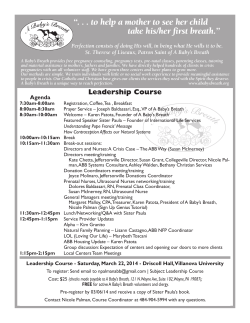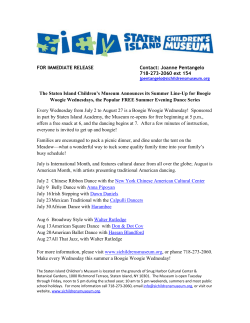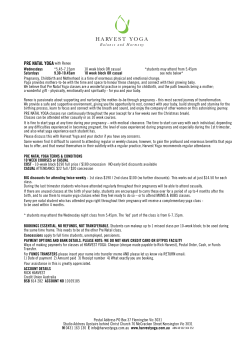
P Movement and dance: deep medicine for pregnancy, labour and birth
Movement and dance: deep medicine for pregnancy, labour and birth Lynn Campbell P regnancy, labour and birth are physical body experiences, and yet so much of women’s preparation for birth takes place in their heads! In contrast, when we use movement and dance as a mode of preparation for birth we open a gateway for connecting to our body wisdom, for remembering our natural instinctive creativity, and for giving ourselves breathing space in which we can connect to the lifeforce energy which is literally growing within. 40 Essentially MIDIRS • April 2013 • Volume 4 • Number 4 The context It is an interesting paradox that so much birth preparation is focused on words, ideas and cognitive thinking. In the words of Uma Dinsmore-Tuli (2006:5) ‘…things to remember in labour is an oxymoron’. Labour and birth are somatic: in other words it is very much about remembering our body wisdom, our mammalian wisdom, and the intelligence of our hormonal, muscular and nervous systems. In antenatal classes that use dance, yoga, breath work, and body movements as a means of preparing for birth, we can work at a deeper physical level. We invite the muscles, bones and cells in our bodies to awaken and remember all they know, and this can create a sense of trust and ease in our body’s ability to give birth — it’s something to lean back into — and we become experts on our own experience! In my Active Birth Yoga classes, which use dance, movement and yoga to promote well-being during pregnancy, we inevitably get on to the topic of ‘how does the baby know?’. By this the participants often mean: how does it know when it’s time to be born? How does it know what is the optimal position for the birth? How do babies know to spiral down the birth canal and articulate their shoulders to navigate the bones of the pelvis? How to mirror facial expressions after birth or latch on to begin breastfeeding? Many people are always astonished and challenged to imagine this kind of knowing. But, of course, it is this kind of knowing that can empower women and guide them in birth. Today we live in a era of a mass increase in materialism, sedentary lifestyles, rising obesity levels, information and advice consumption (and often overload), technological advances, and mass marketing — these are times when this kind of knowing is crucial. Movement and dance classes I have run body work classes for pregnancy in the north east of England for almost 12 years. The intention of the classes is to promote well-being during pregnancy and to help women feel prepared and that they have resources to call on during labour and birth. In the following sections I will explore different elements of a movement/yoga/dance class, describing what we actually do and examining some of the intentions and layers of research that support what we do. It may be interesting to note that I often collaborate and offer training to midwives, belly dancers, NCT practitioners, and voice workers, so most elements of these classes can be adapted and ‘dovetailed’ with other modes of birth preparation. The warm up This element of the class offers: • • • • • A chance for women to move each body part in turn, supported by the music and their own breathing. There is an invitation right from the start for women to go at their own pace, listening to their body and making movements that are bigger/smaller/suitable for their own bodies on that particular day. This encourages women to become an authority on what’s right for them. Women experience a massage from their movement and their breath — we begin turning attention to how we are, and to the breath and how it can become complete (I will discuss this in more detail later). Time for women to become present, rooted, grounded, earthed and in tune with gravity. A wake-up for women’s physical systems, increasing blood flow, building strength and body awareness. A chance for women to connect with their unborn baby and focus on how they are feeling today. After working through and warming up individual body parts we walk through the space to feel the echo of the work of the warm up. This enables women to digest what they have felt and discovered about themselves so far, and to imagine how they can move with this awareness everyday and during the birth dance. Fluid, breathing postures The posture work element of the classes is derived from the Hatha yoga lineage which informs Active Birth Yoga. During my 11 years of teaching, the postures I use have become more and more fluid, with space to adapt the positions and feel the internal dance that enables women to listen deeply to their bodies. This element of the class offers: • A chance for women to explore the complete breath. By this I mean steady outbreaths through the mouth, enjoying the natural pause at the end of the outbreath, then always Essentially MIDIRS • April 2013 • Volume 4 • Number 4 © Oran Milstein This article will explore how giving women the space to move, and space to breathe, during birth preparation classes can help them to remember the innate intelligence within their bodies and feel more ready for labour and birth. 41 © Oran Milstein “It is important not to rush the breathing, but feel the body releasing a little more with each outbreath. Trying out the complete breath and practising it is key to its success” 42 Essentially MIDIRS • April 2013 • Volume 4 • Number 4 being easy and welcoming with the inbreath (via the nose or mouth). It is important not to rush the breathing, but feel the body releasing a little more with each outbreath. Trying out the complete breath and practising it is key to its success. A good example of the power of the complete breath is the understanding of how a muscular stretch can feel at its full extension but with a focused breath the muscle can release some more; or how arms can feel achey but when offered a strong breath they can be re-energised. • • • Women have the opportunity to connect to the elements. I ask women to use their sense of being connected to the natural world and its elements to energise the postures, for example we tune in to the support of the earth beneath our feet. We also take time to feel how our body lifts and grows toward the sun — making more space for the breath, baby, organs and spine, and to notice the fluidity of the waters within the body, and the ease of the flow of the nourishing air. • • • We practise not pushing but not holding back either, which is such a useful tool in body work, life and of course during labour and birth. Encouragement for women to let the postures become all they can be by giving them time, proceeding gently and yet bringing our attention and commitment to opening a little more, one breath at a time • Movement meditations These dance and movement meditations support women to move more freely, following their instincts while exploring and embodying ideas and images that may be useful for labour and birth. I drum through the rhythm of a series of contractions, using a wave-like pattern with a build-up, crescendo and slide down… then a short pause… then another contraction. The group are invited to try a range of possible birth positions, using the walls, birth balls, the floor, bean bags,and chairs. The women practise using complete breaths, staying soft, open, mobile, forward, and upright, while really listening in to their bodies. We also visualise bringing some of this softness and strength with us into the labour and birth. Some of the moving meditations we explore include: • Trying out various birth positions. We move through a range of ways to be upright, soft, open and listening in — I used to teach actual positions during the classes, but this has evolved into something more creative, and less prescriptive, where the flow, softness and tuning into your own body is more important than the actual position. Out of this section of the class comes a sense that women will just know where they need to be during their labour, and if their bodies have physically tried out a range of positions then they will be easier to drop into on the day of the birth. Practicing softness and resilience. We dance into a soft place so that women can play with adding stronger breath, a clearer sense of being rooted, and develop a sense of their own power and being up for the challenge of labour and birth. Letting go of tension. This is where the women dance with the intention of letting go of anything that they don’t need, such as feelings of stress, muscular tension, or fears about the birth. We may use images of water washing over us and through us or imagine gravity massaging tension or simply shake out the body. Gravity massages and sacral massages. Sometimes this dance is done with birth partners and sometimes with other women in the group. I think of it as a dance as it is not didactic, rather as a suggestion of offering women massage in different positions and enabling them to stay in communication with others around them. Drumming contractions. I always get very strong positive feedback about how stirring and useful this dance is. These dancing rituals can be found in the traditions of cultures all over the world and throughout the ages, rituals where women have gathered to nurture the support, surrender and strength for the birth (Jackson 1999). Relaxation and feeling the echo At the close of the class we rest, with the intention of simply digesting the work of the class and letting our body memory settle. Sometimes we add a guided meditation which links to the themes of the class, such as: • • • • Softening and relaxing body parts, visualising the baby nourished, nurtured and soft Having time to rest and be held by the earth, alongside this sense of being supported, thinking of other things or people that give us support Gratitude, and breathing into a sense of all the things we are grateful for Connecting to ourselves, to the babies, to each other, to the other women in the group, to women all over the world giving birth, and to our ancestors and our children’s children who have, and will, give birth. Essentially MIDIRS • April 2013 • Volume 4 • Number 4 43 © Oran Milstein “Many midwives have told me that when they remind women to lean into the intelligence of their bodies and to follow their instincts and take complete breaths that they too benefit from the opening, the softening and the wisdom” Discussion The benefits of exercise in pregnancy are well documented and include healthy blood flow to mother and baby, a balancing effect on the neuro-endocrine system, combating fatigue and reducing stress, as well as promoting a shorter labour, reduced birth complications and faster postnatal recovery (Hassall 2011). There is also a wealth of recent evidence from the field of neuroscience which indicates that these well-being factors during pregnancy have a direct effect on the well-being of the developing baby (Axness 2012). In addition to these physical elements of well-being, dance and moving 44 Essentially MIDIRS • April 2013 • Volume 4 • Number 4 meditations bring opportunities for awareness and connection to ourselves, the baby, nature and the wider picture. Women who come along and dance in my classes report sleeping well after the class, feeling less achey and less anxious, but the most consistent feedback is about feeling more positive, more aware, more trusting of their bodies and more connected to their babies. In the words of a recent class participant: ‘I felt up for it — I’d imagined the birth and danced it, so it was like I could remember that my body knew its stuff... I felt like I had a bag of tools to use or not use... usually I’m a thinker and a planner but this time my plan was to take it one breath at a time’. © Oran Milstein Conclusion I hope some of the ideas outlined in this article may be useful to those involved in planning antenatal classes or in supporting women in labour and birth. Many midwives have told me that when they remind women to lean into the intelligence of their bodies and to follow their instincts and take complete breaths, that they too benefit from the opening, the softening and the wisdom. References Axness M (2012). Parenting for peace: raising the next generation of peacemakers. Boulder, CO: Sentient Publications. Darling Khan S, Darling Khan Y (2009). Movement medicine: how to awaken, dance and live your dreams. London: Hay House. Dinsmore-Tuli U (2006). Mother’s breath: a definitive guide to yoga breathing, sound and awareness practices during pregnancy, birth, post-natal recovery and mothering. London: Sitaram and Sons. Hassall J (2011). Exercise in pregnancy: a review of the current evidence and guidelines. Essentially MIDIRS 2(1):39-42. Jackson D (1999). Eve’s wisdom: traditional secrets of pregnancy, birth and motherhood. London: Duncan Baird Publishers. Lynn Campbell BA (Hons), PGCE, MA is a dance teacher and an Active Birth Teacher. She has trained as a Dance Movement Psychotherapist (MA), an NCT teacher, and is a Movement Medicine teacher. She has weaved all these complementary threads together in 12 years of specialising in body work classes for pregnant women. She teaches regular sessions in the north east of England for the NHS at the Royal Victoria Infirmary, at the Sage Gateshead offering body work and lullabies, at Newcastle Pregnancy and Baby Centre offering Movement Meditations and Belly Dancing, and at Dance City. She also is a visiting lecturer at Northumbria University offering Active Birth training sessions to midwives and regularly travels to conferences and training programmes. Essentially MIDIRS • April 2013 • Volume 4 • Number 4 45
© Copyright 2025





















